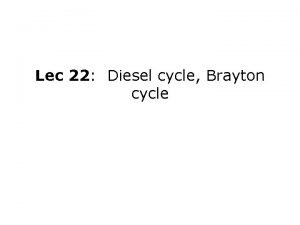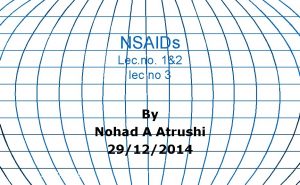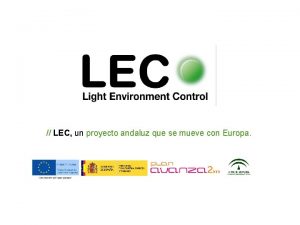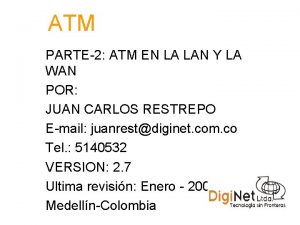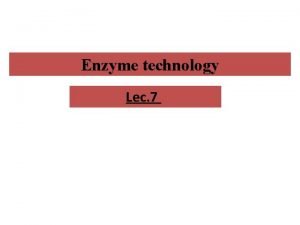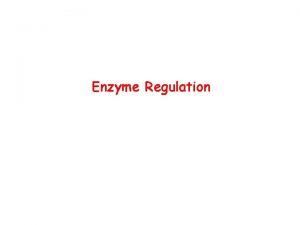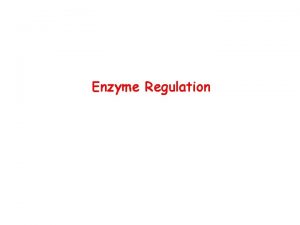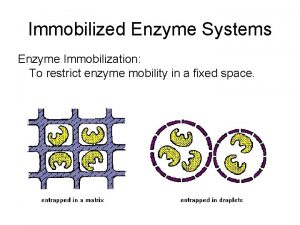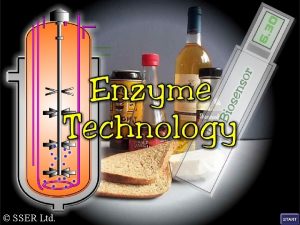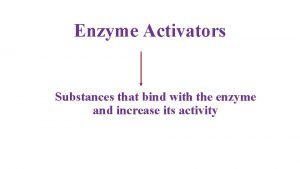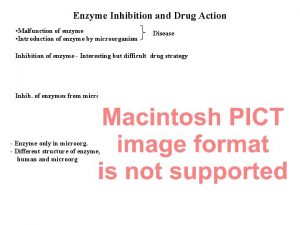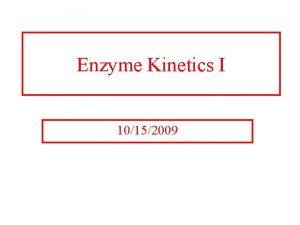Enzyme technology Lec 7 Enzyme technology Enzyme technology



















- Slides: 19

Enzyme technology Lec. 7

Enzyme technology : Enzyme technology is the study of industrial enzymes and their uses.

The advantages and disadvantages of using enzymes are directly related to their properties: Advantages Disadvantages They are specific in their action and They are highly sensitive to changes in physical are therefore less likely to produce and chemical conditions surrounding them. unwanted by-products They are biodegradable and They are easily denatured by even a small therefore cause less environmental increase in temperature and are highly pollution susceptible to poisons and changes in p. H. Therefore the conditions in which they work must be tightly controlled. They work in mild conditions, i. e. low The enzyme substrate mixture must be temperatures, neutral p. H and normal uncontaminated with other substances that atmospheric pressure, and therefore might affect the reaction. are energy saving

Types of microbial enzymes According to there work According to there exist Constitutive enzymes Intracellular enzymes Adaptive enzymes Extracellular enzymes

Comparing intra- and extra- cellular enzymes Intracellular enzymes More difficult to isolate Cells have to be broken apart to release them Extracellular enzymes Easier to isolate No need to break cells – secreted in large amounts into medium surrounding cells Have to be separated out from cell debris and a Often secreted on their own or with a few other mixture of many enzymes and other chemicals enzymes Often stable only in environment inside intact cell More stable Purification/downstreaming processing is difficult/expensive easier/cheaper

Isolating the Enzyme Pure enzymes are needed for commercial use; therefore microbes must be grown in aseptic conditions, free from contaminants. It is necessary to prevent contamination with other bacteria since: • There may be competition for nutrients. • The required enzyme may not be produced as readily. • The end-product may be contaminated and unsafe.


Uses of enzymes Depending on the applications of enzymes, they are grouped into four broad categories: 1 - Therapeutic uses Enzyme source Application streptokinase Streptococcus pyogenes Removal of fibrin clots L-asparaginase E. coli Cancer chemotherapy L-glutaminase Treatment of leukemia Achromobacter spp. β-galactosidase Lactobacilli spp. Treatment intolerance of lactose

2 -Manipulative uses Enzyme source Application lysozyme Hen egg disrupts mucopeptide white bacterial cell walls nuclease bacteria genetic manipulation of 3 - Analytical uses Enzyme source Application Glucose oxidase urease Aspergillus niger Detection of glucose in blood Jack beans Measurement of urea in body fluids

4 - Industrial uses. The industrial use of enzymes (not using the whole microbe) Enzyme alpha-amylase source Bacillus spp. Application Conversion of starch to glucose or dextrans in food industry proteases Bacillus spp. Laundry aid Glucose isomerase Streptomyces spp. Production of high fructose syrups rennin bacteria Cheese making The industrial use of enzymes (using the whole microbe) Industry Microbe Brewing and baking Saccharomyces cerevisiae Vinegar production Acetobacter Yoghurt production Lactobacillus

Improving the Enzyme: Immobilization: The process whereby the movement of enzymes, cells, organelles, etc. in space is completely or severely restricted usually resulting in a water-insoluble form of the enzyme. ” Immobilized enzyme: An enzyme fixed by physical or chemical means to a solid support to confine a reaction of interest to a particular site.

Advantages of enzyme immobilization: 1 - Enzyme can be recovered and reused. 2 - Immobilized enzymes are usually more stable. 3 - Ability to stop the reaction rapidly by removing the enzyme from the reaction solution. 4 - Product is not contaminated with the enzyme, no purification required. 5 - Easier to separate enzyme and products. 6 - Allows development of a multienzyme reaction system. 7 - Reduces effluent disposal problems.

Disadvantages of enzyme immobilization: 1 - Immobilization may alter shape of enzyme. 2 - May alter catalytic ability. 3 - Enzyme may become detached. 4 - Expensive.

There are four main methods available for immobilizing enzymes: 1) Adsorption This method is based on the physical adsorption of enzyme protein on the surface of water-insoluble carriers such as glass or alginate beads. The bond between the enzyme and carrier molecule involves electrostatic forces such as vanderwaal forces, ionic bridges and hydrogen bonds.

2)Entrapment In entrapment the enzymes or cells are simply trapped inside the polymer matrix. Polymers like polyacrylamide, collagen, cellulose acetate, calcium alginate or carrageenan etc are used as the matrices. 1. Occlusion within a cross linked gel: In this entrapment method, a highly cross-linked gel is formed as a result of the polymerization which has a fine "wire mesh" structure.

2. Microencapsulation: This entrapment involves the formation of spherical particle called as “microcapsule” in which a liquid or suspension of biocatalyst is enclosed within a semi permeable polymeric membrane.

3)Covalent binding This method involves the formation of covalent interactions between the functional groups present on the support surface and those present on the amino acid residues on the enzyme surface.

4)Cross linking This method is based on the formation of covalent bonds between the enzyme molecules leading to three dimensional cross linked aggregates. The most common reagent used for cross-linking is glutaraldehyde.

 Lec
Lec 1 lec
1 lec Lec ditto
Lec ditto History of software development life cycle
History of software development life cycle Ir.ac.kashanu.register://h
Ir.ac.kashanu.register://h Lec renal
Lec renal Lec elements
Lec elements Diesel lec
Diesel lec Art 455 lec
Art 455 lec Fenemates
Fenemates Scoreboarding computer architecture
Scoreboarding computer architecture Sekisui s-lec america llc
Sekisui s-lec america llc Tipos de lec
Tipos de lec 252 lec
252 lec August lec 250
August lec 250 Lec promotion
Lec promotion Scoreboard computer architecture
Scoreboard computer architecture Lec
Lec Lec barbate
Lec barbate Componentes del lec
Componentes del lec







